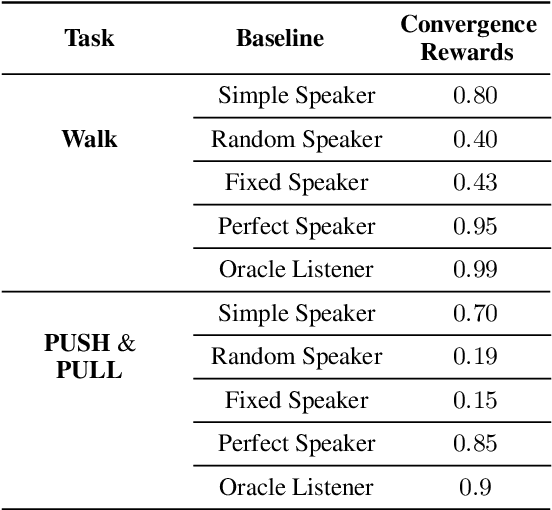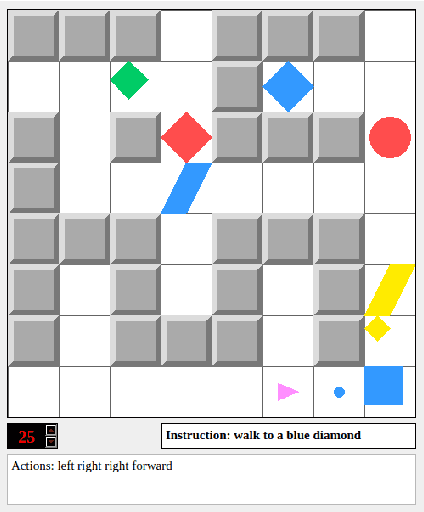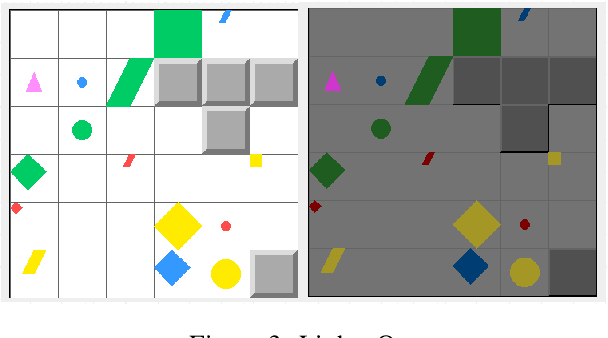Sonu Dixit
gComm: An environment for investigating generalization in Grounded Language Acquisition
May 16, 2021



Abstract:gComm is a step towards developing a robust platform to foster research in grounded language acquisition in a more challenging and realistic setting. It comprises a 2-d grid environment with a set of agents (a stationary speaker and a mobile listener connected via a communication channel) exposed to a continuous array of tasks in a partially observable setting. The key to solving these tasks lies in agents developing linguistic abilities and utilizing them for efficiently exploring the environment. The speaker and listener have access to information provided in different modalities, i.e. the speaker's input is a natural language instruction that contains the target and task specifications and the listener's input is its grid-view. Each must rely on the other to complete the assigned task, however, the only way they can achieve the same, is to develop and use some form of communication. gComm provides several tools for studying different forms of communication and assessing their generalization.
Zero-Shot Generalization using Intrinsically Motivated Compositional Emergent Protocols
May 11, 2021



Abstract:Human language has been described as a system that makes \textit{use of finite means to express an unlimited array of thoughts}. Of particular interest is the aspect of compositionality, whereby, the meaning of a compound language expression can be deduced from the meaning of its constituent parts. If artificial agents can develop compositional communication protocols akin to human language, they can be made to seamlessly generalize to unseen combinations. Studies have recognized the role of curiosity in enabling linguistic development in children. In this paper, we seek to use this intrinsic feedback in inducing a systematic and unambiguous protolanguage. We demonstrate how compositionality can enable agents to not only interact with unseen objects but also transfer skills from one task to another in a zero-shot setting: \textit{Can an agent, trained to `pull' and `push twice', `pull twice'?}.
Infinite use of finite means: Zero-Shot Generalization using Compositional Emergent Protocols
Dec 13, 2020



Abstract:Human language has been described as a system that makes use of finite means to express an unlimited array of thoughts. Of particular interest is the aspect of compositionality, whereby, the meaning of a complex, compound language expression can be deduced from the meaning of its constituent parts. If artificial agents can develop compositional communication protocols akin to human language, they can be made to seamlessly generalize to unseen combinations. However, the real question is, how do we induce compositionality in emergent communication? Studies have recognized the role of curiosity in enabling linguistic development in children. It is this same intrinsic urge that drives us to master complex tasks with decreasing amounts of explicit reward. In this paper, we seek to use this intrinsic feedback in inducing a systematic and unambiguous protolanguage in artificial agents. We show in our experiments, how these rewards can be leveraged in training agents to induce compositionality in absence of any external feedback. Additionally, we introduce Comm-gSCAN, a platform for investigating grounded language acquisition in 2D-grid environments. Using this, we demonstrate how compositionality can enable agents to not only interact with unseen objects, but also transfer skills from one task to other in zero-shot (Can an agent, trained to pull and push twice, pull twice?)
 Add to Chrome
Add to Chrome Add to Firefox
Add to Firefox Add to Edge
Add to Edge